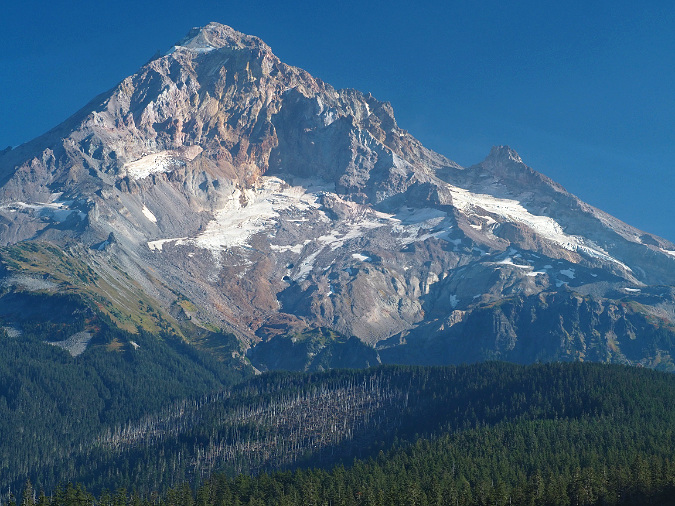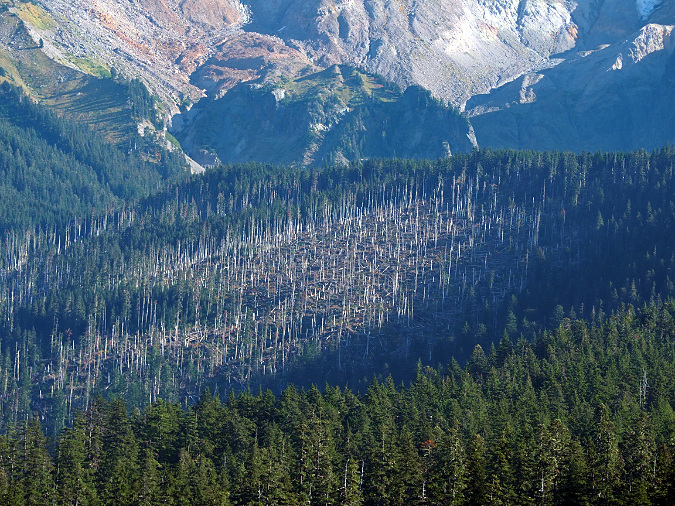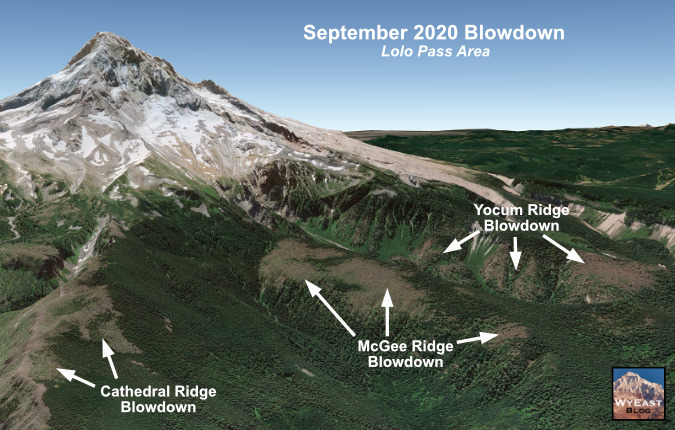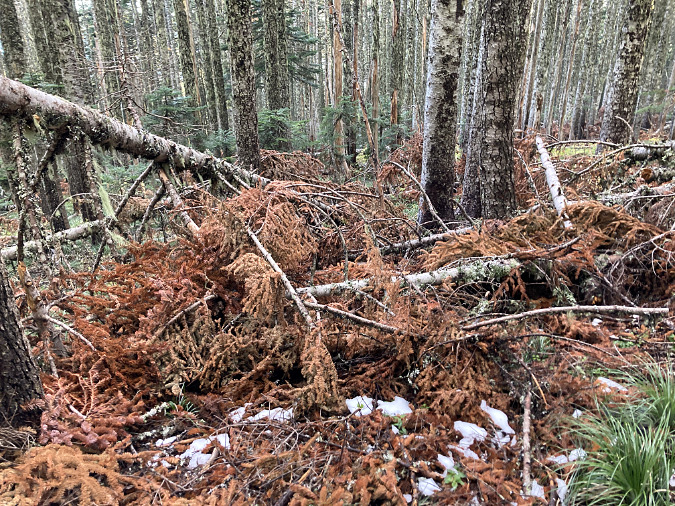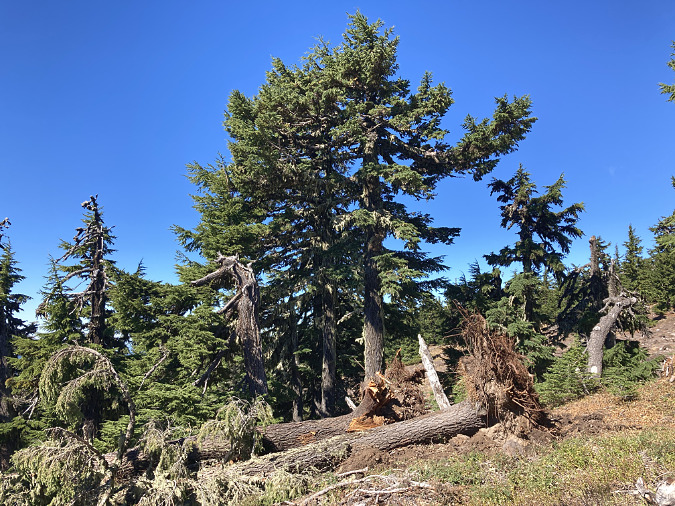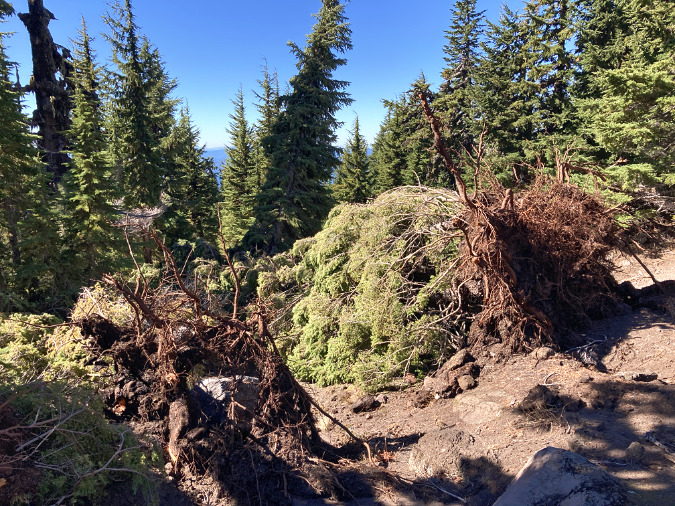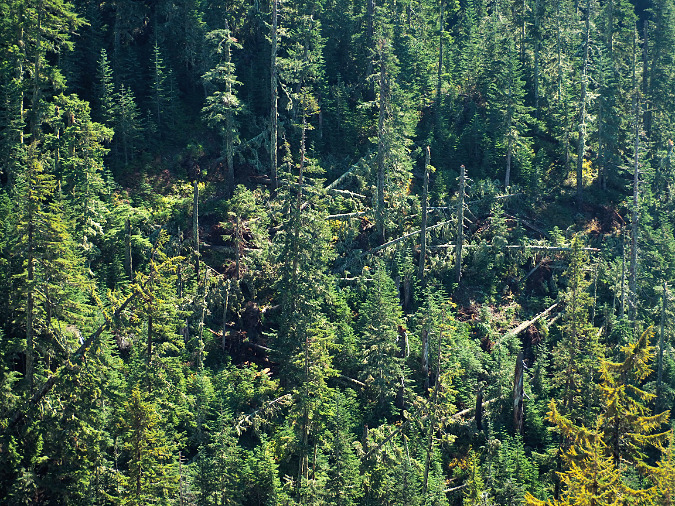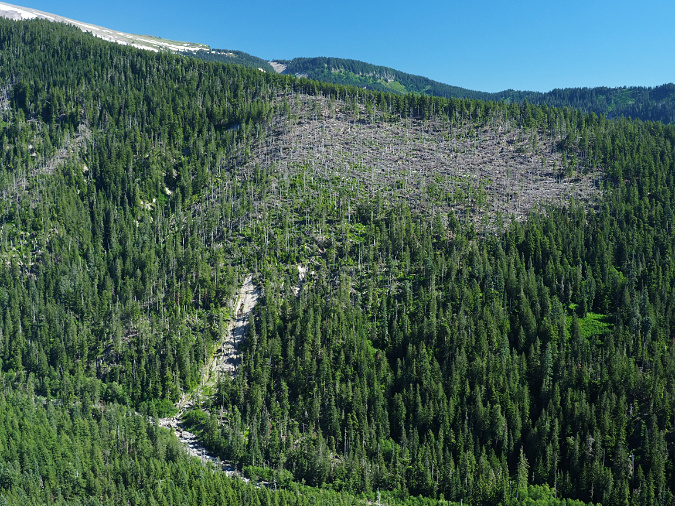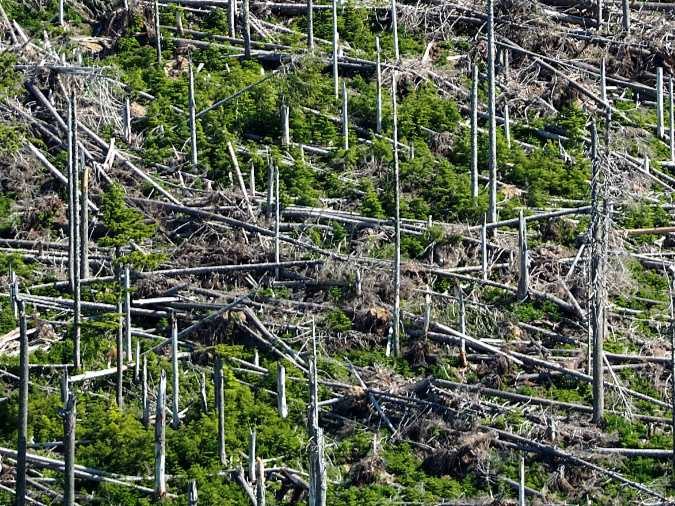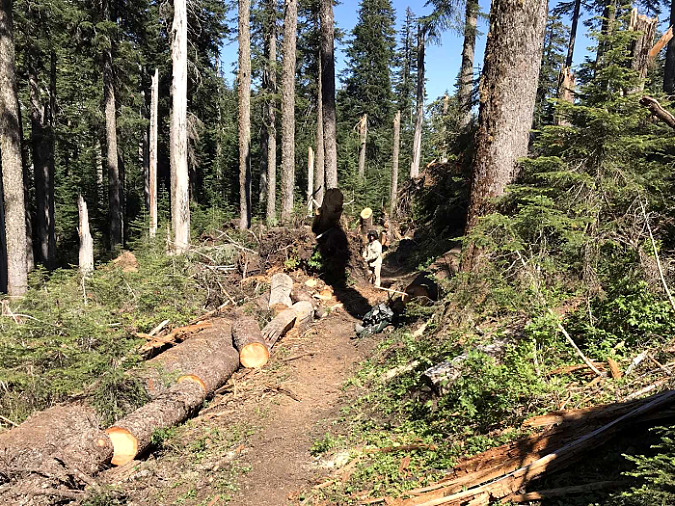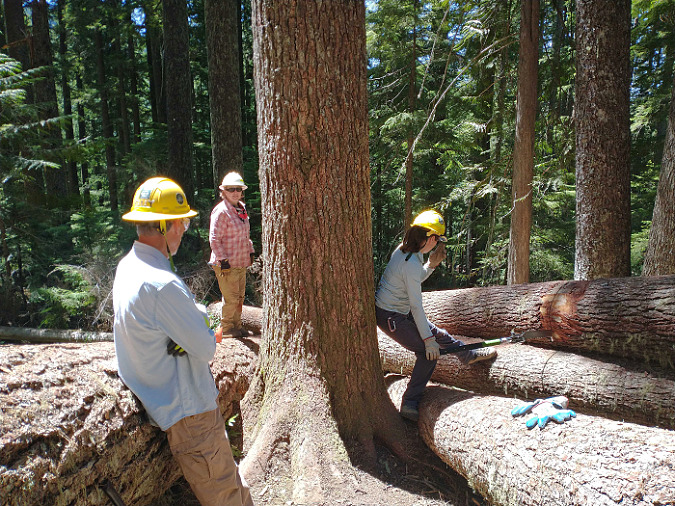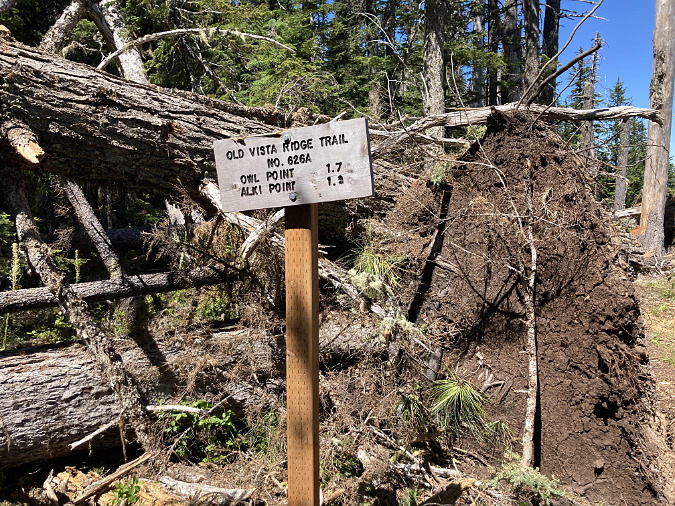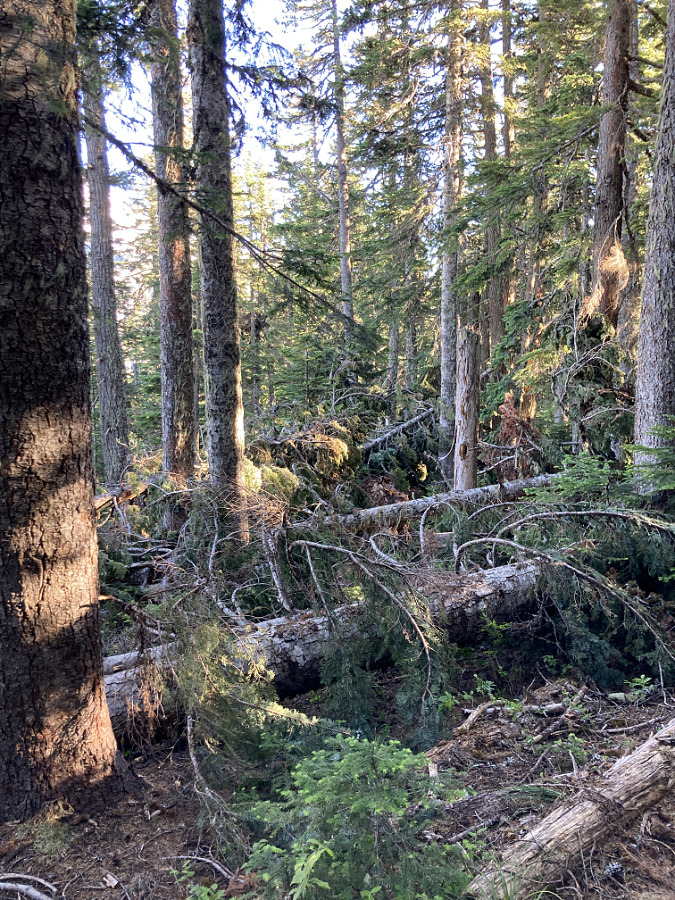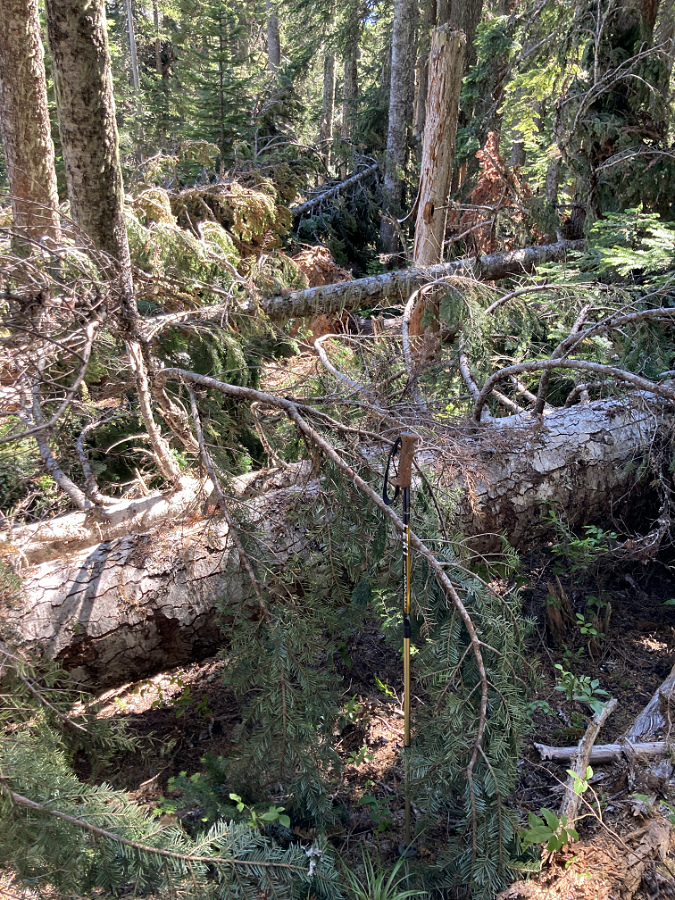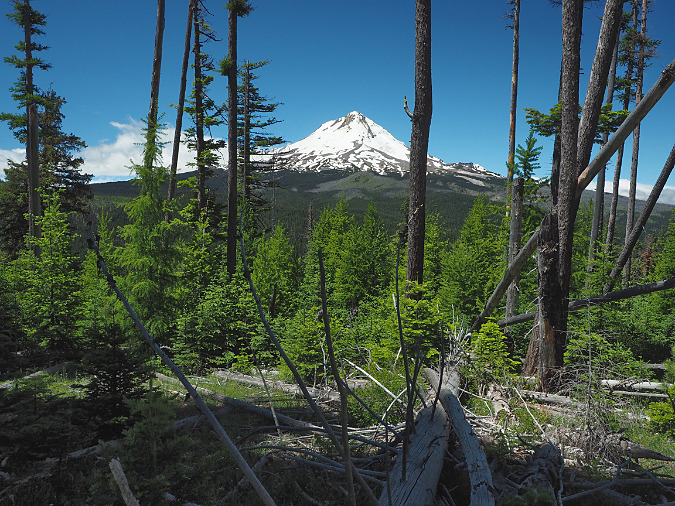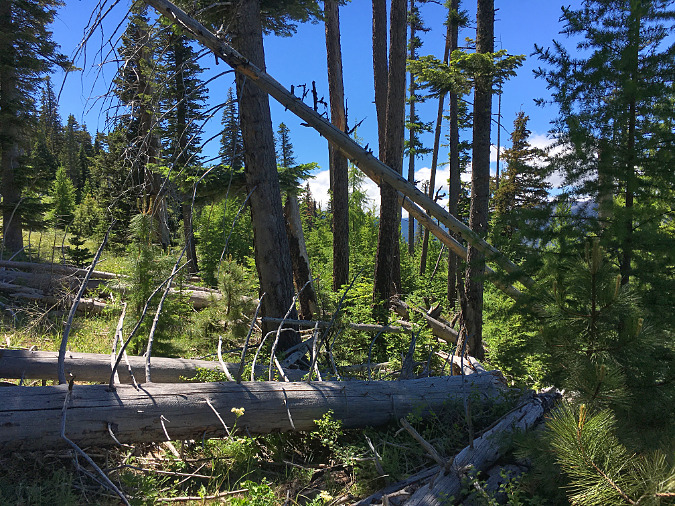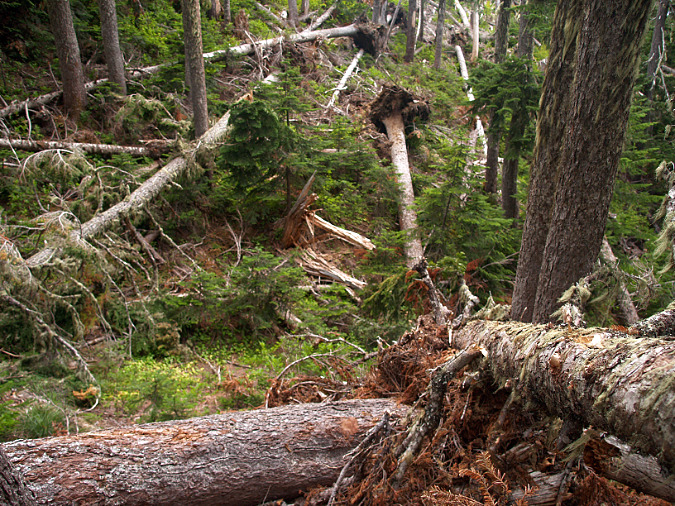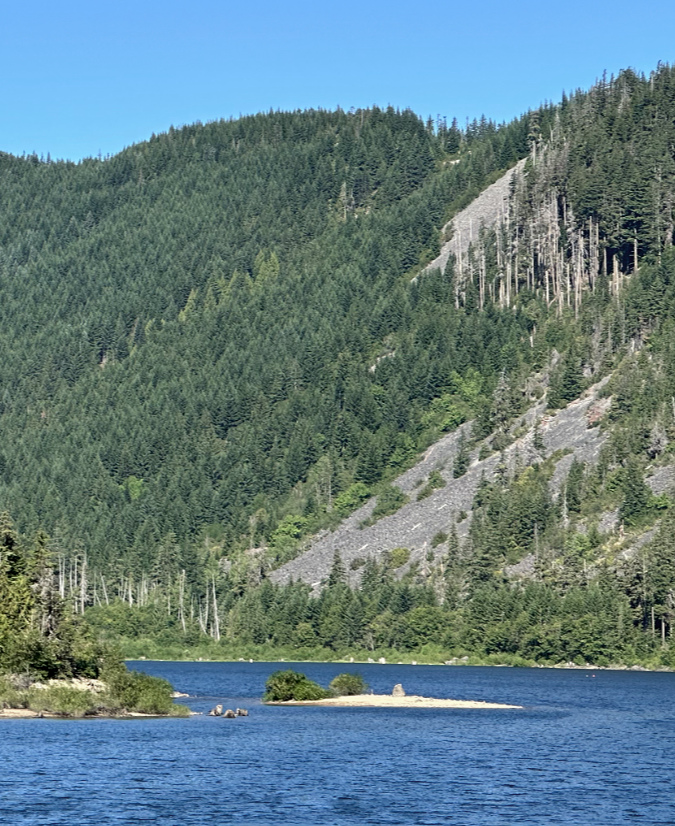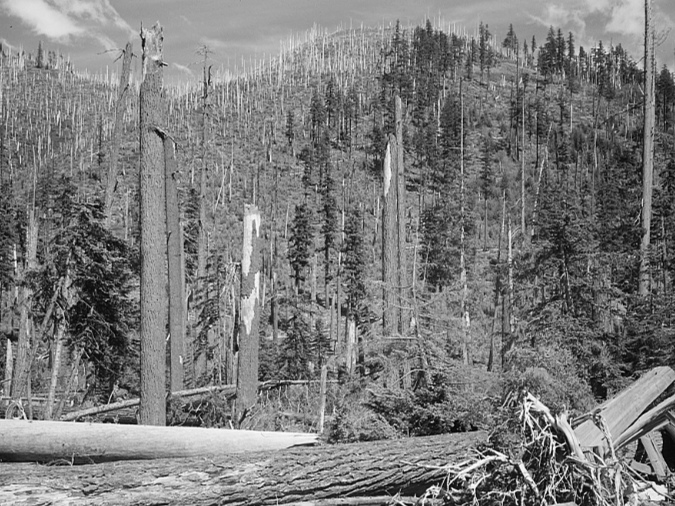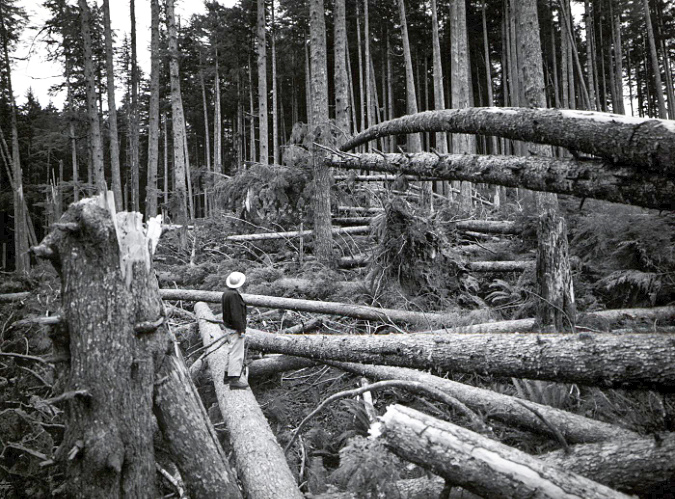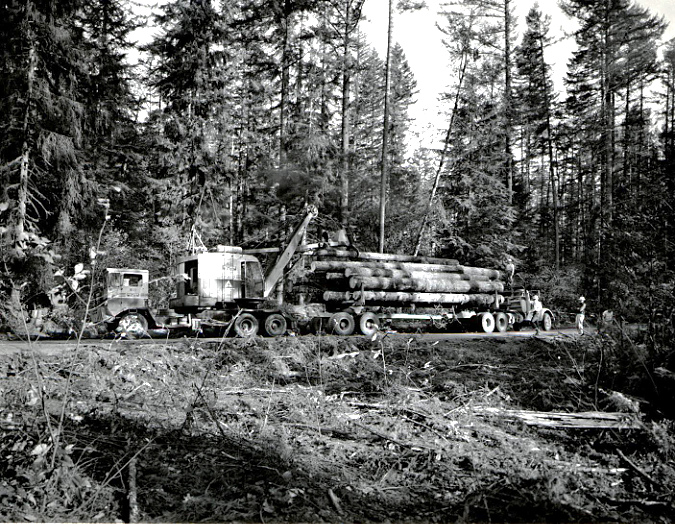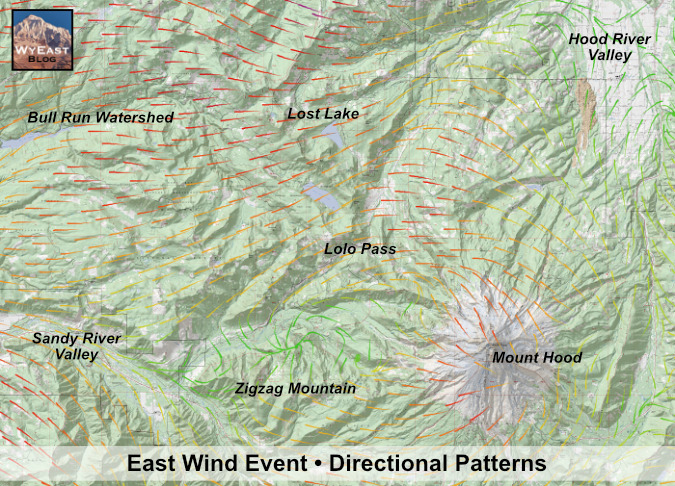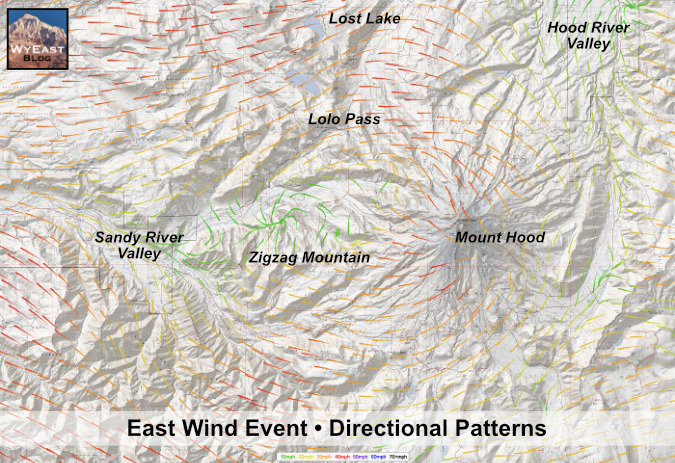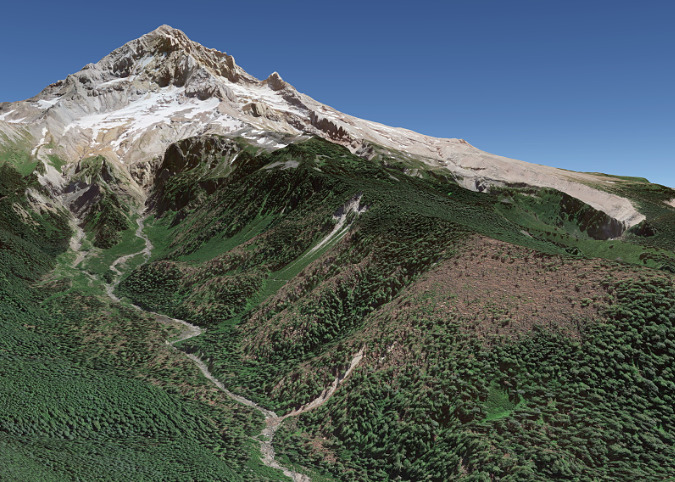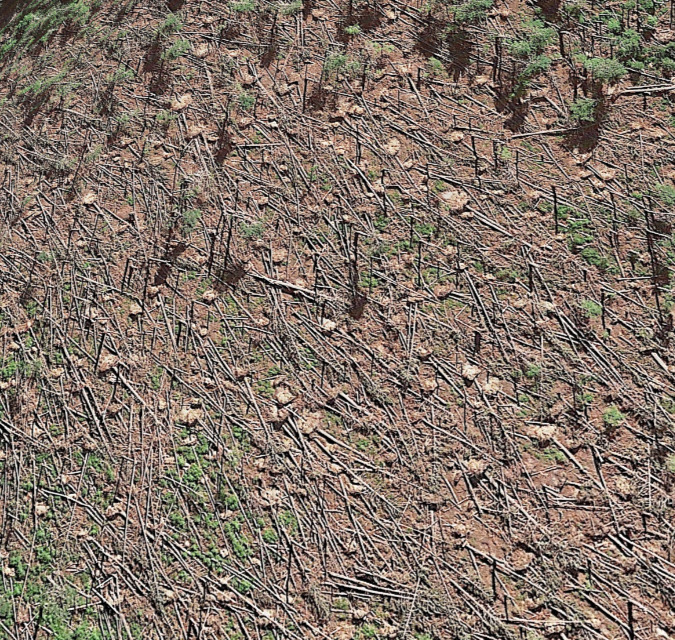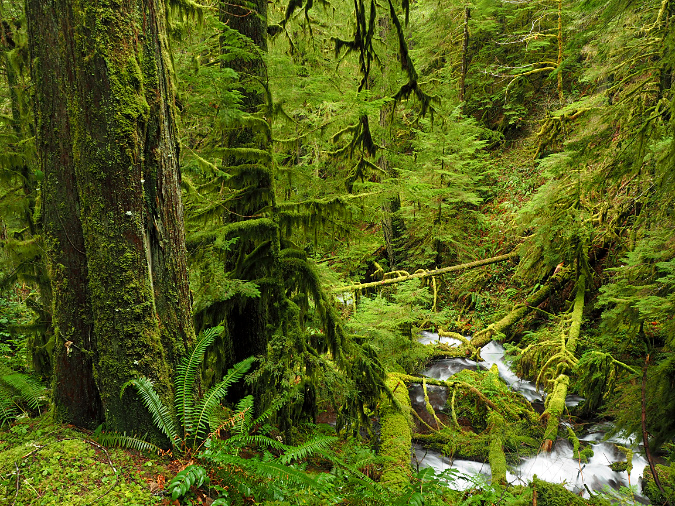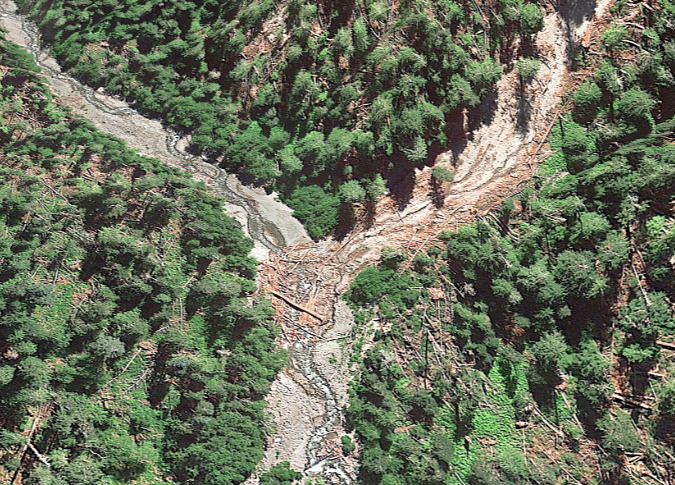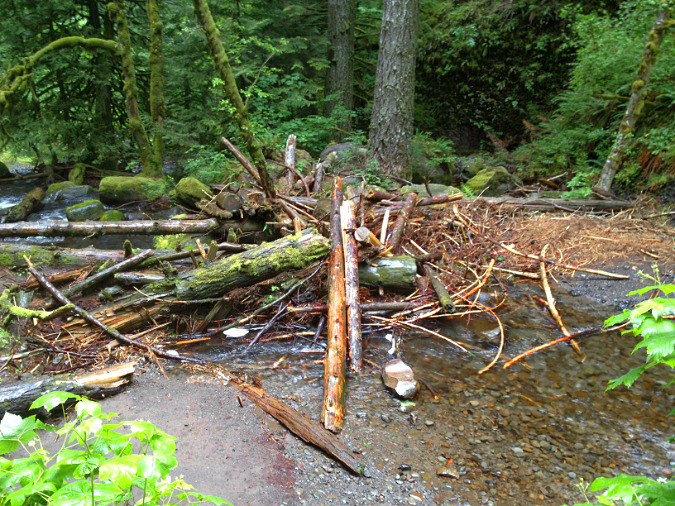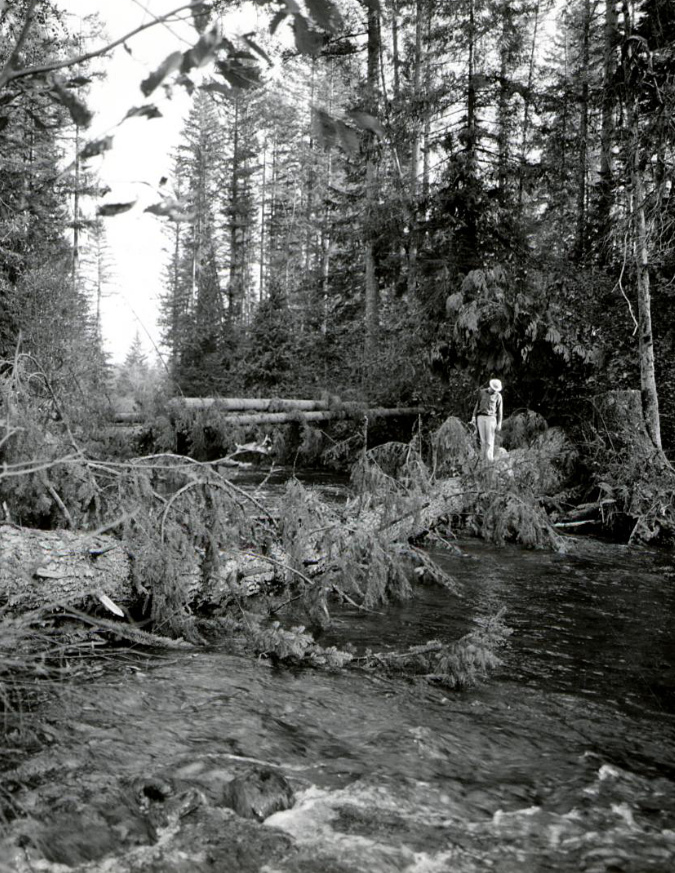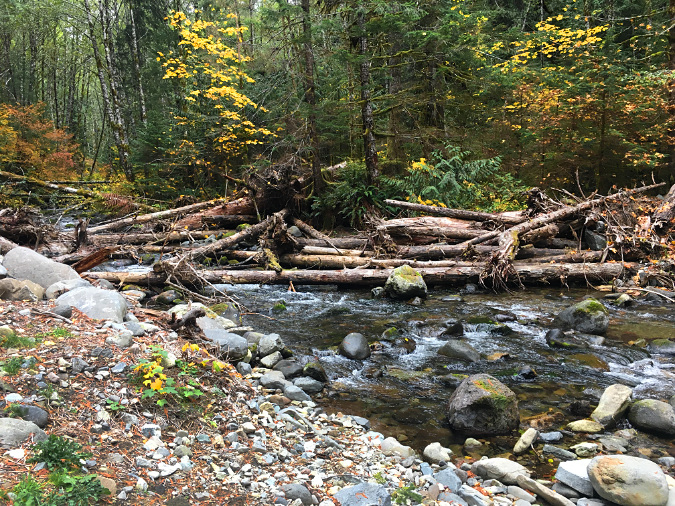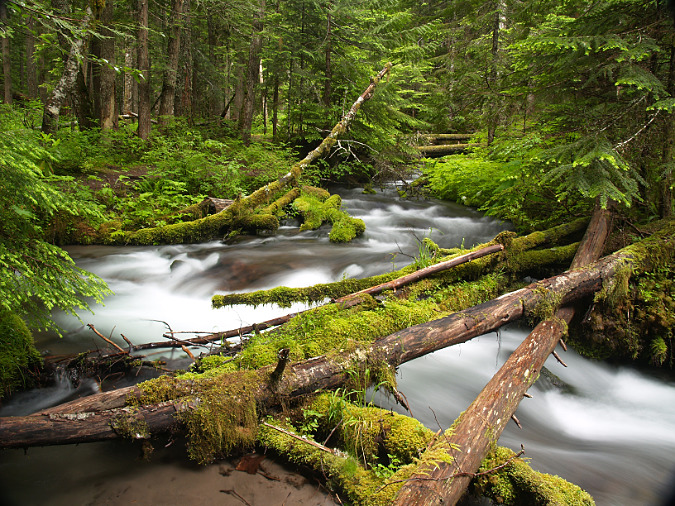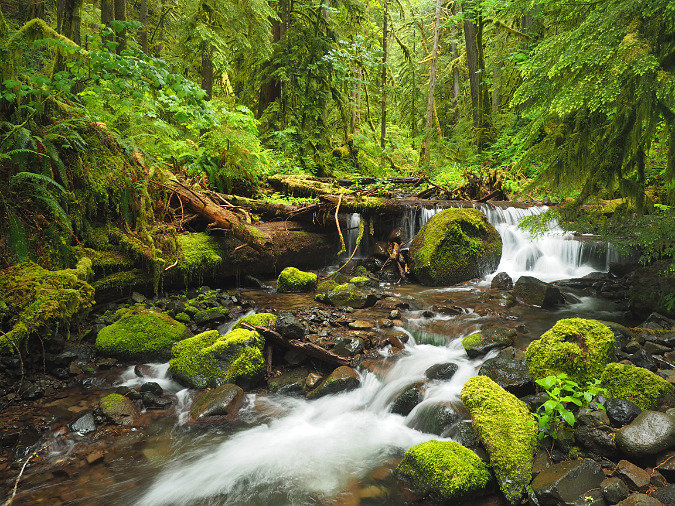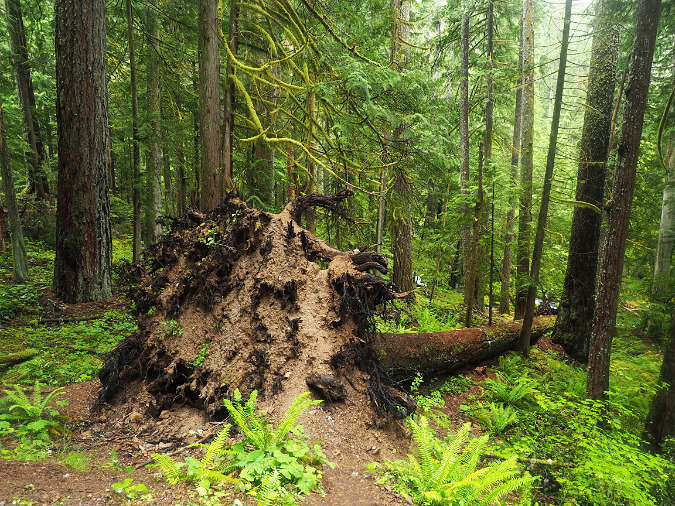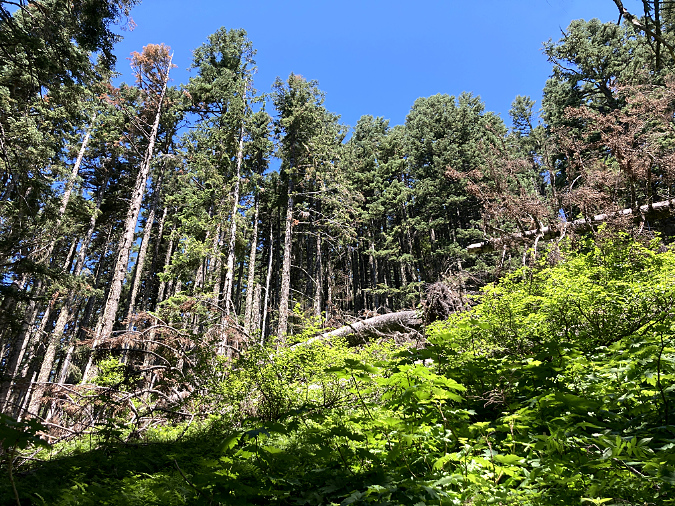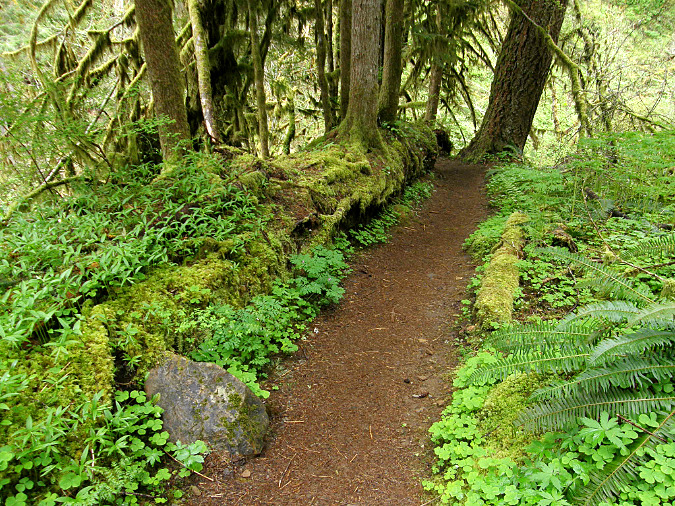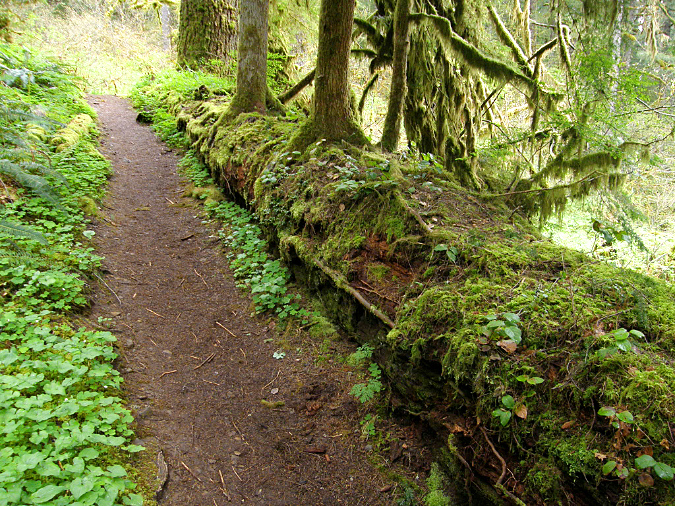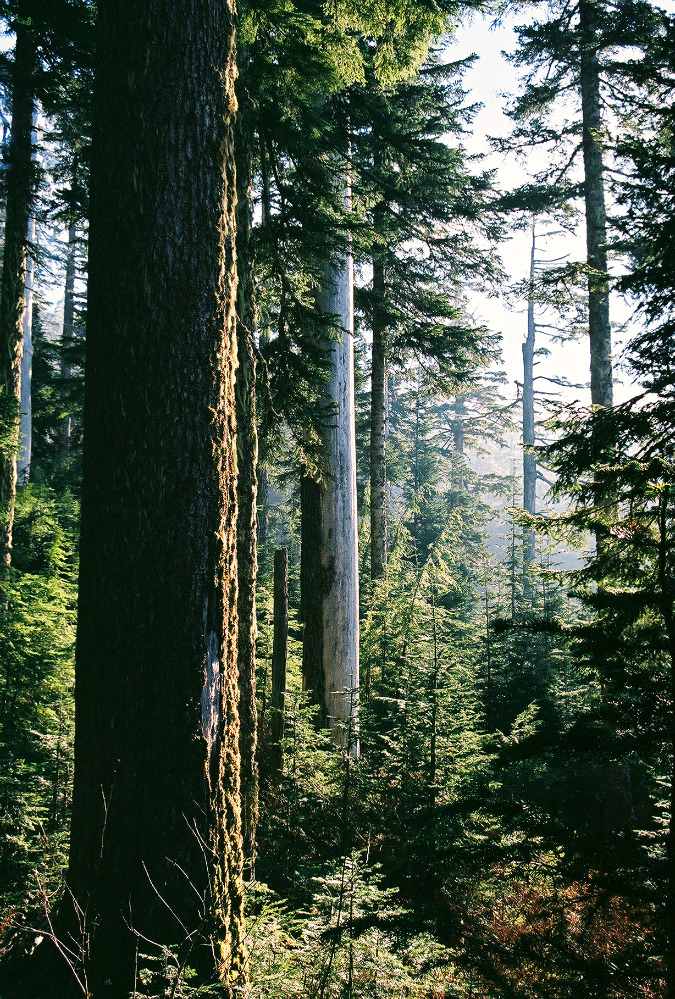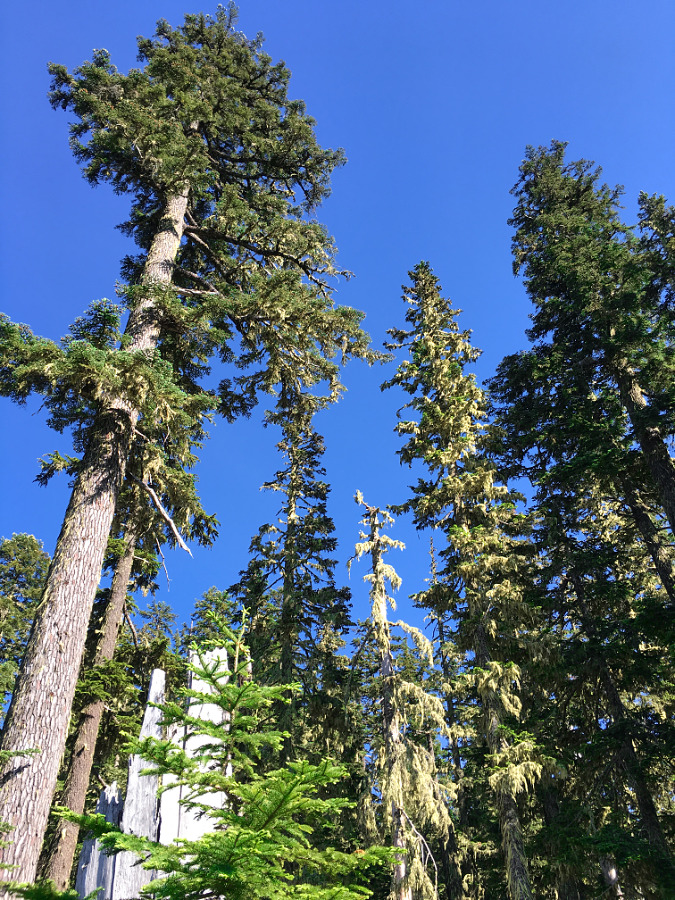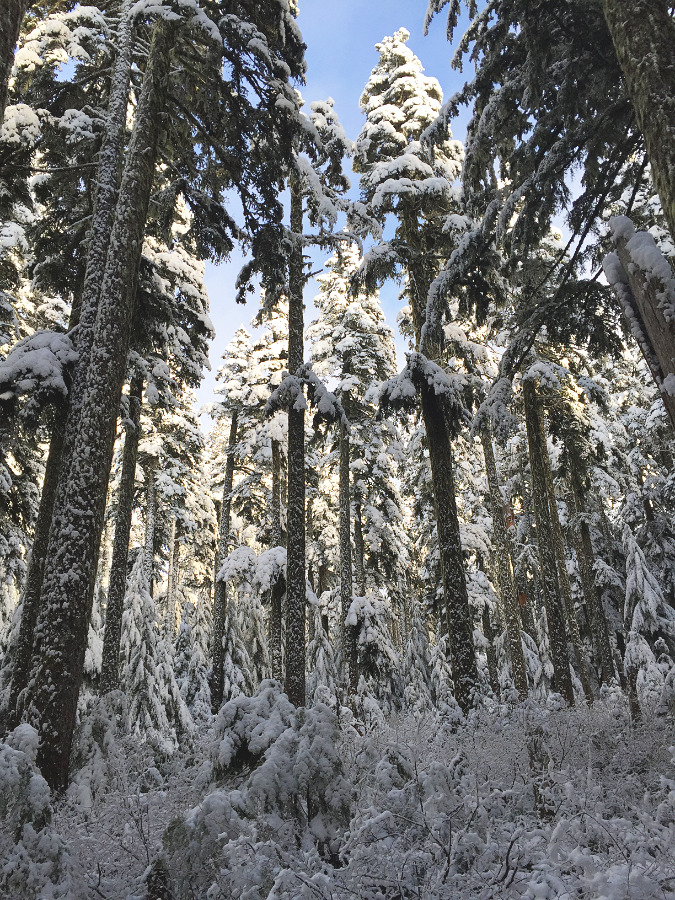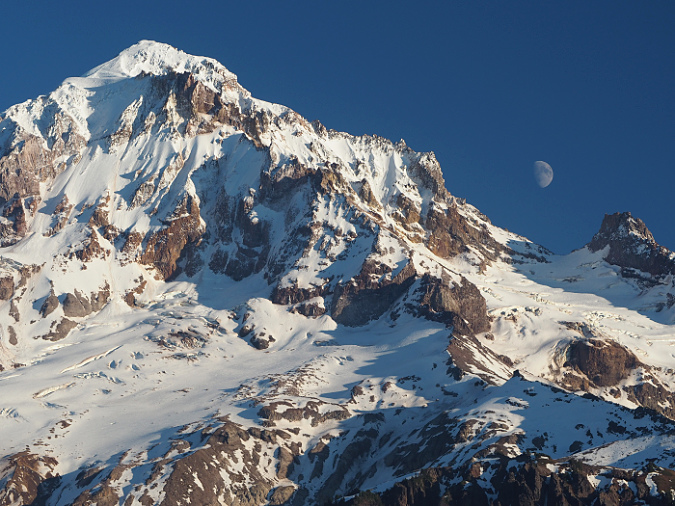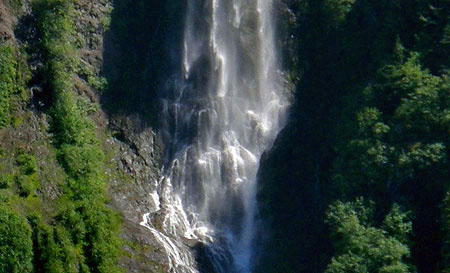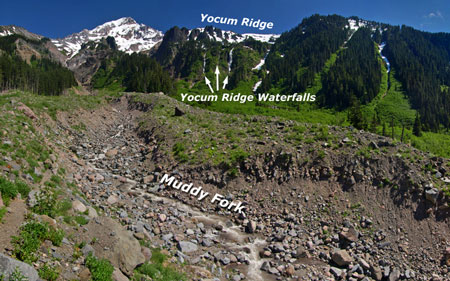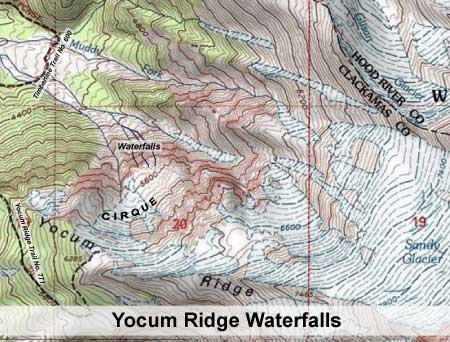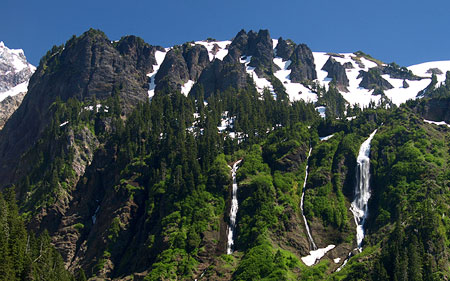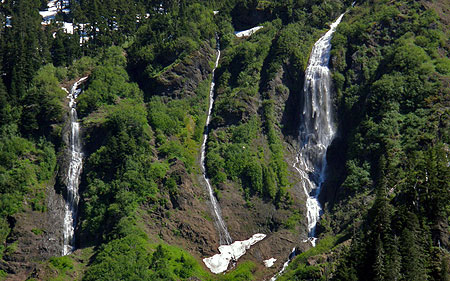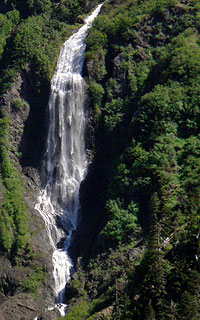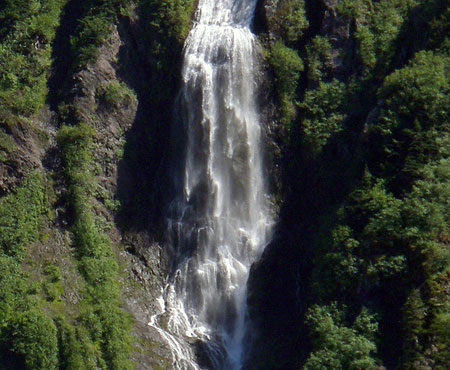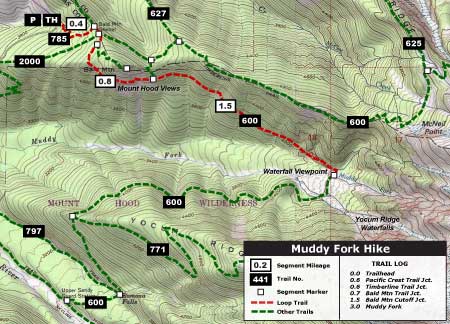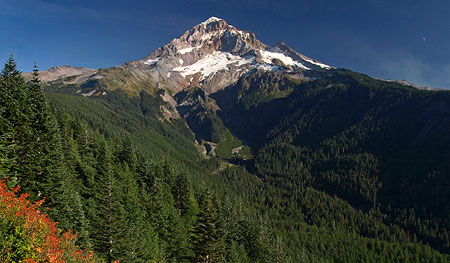Blowdown from the 2020 wind storm on Mount Hood’s McGee Ridge
The spectacle and impact of the massive forest fires that exploded in the northern Oregon Cascades in September 2020 overshadowed widespread blowdown events that might otherwise have made headlines at the time. The two were linked, with a strong east-west atmospheric pressure gradient producing gale-force winds along the Cascade Crest during the driest month of our annual summer drought.
Like the recent forest fires in the Gorge, on Mount Hood and the Riverside Fire that swept much of the Clackamas River watershed, many of the recent blowdowns on Mount Hood are in plain sight and have since added to the public anxiety over the future of Mount Hood’s forests.
On Mount Hood’s slopes there were large areas of blowdown from this event along Cathedral Ridge, McGee Ridge and Yocum Ridge, with smaller blowdown patches scattered along other ridges around the mountain and on smaller peaks along the Cascade Crest. One of the more prominent blowdown areas on the shoulder of McGee Ridge is prominently visible from Lolo Pass (shown in the opening photo and below).
Closer view of blowdown on McGee Ridge
Detailed view of blowdown on McGee Ridge
The visual impact of whole forest stands being toppled like matchsticks is jarring enough, but in the case of the Yocum Ridge blowdown, an entire section of the Timberline Trail was also impacted.
While these events seem new and troubling, blowdowns — like wildfires – are endemic to our forest ecosystem. As such, blowdowns have emerged in recent years as a topic of increased interest to forest scientists. This article draws from the changing understanding of extreme wind events as a normal, mostly beneficial contributor to forest health in WyEast Country, complementing natural forest fires in surprising ways.
Recent Events on Mount Hood
The recent blowdown events on Mount Hood are hard to miss for those who spend time on the many trails that encircle the mountain. Most occurred during the September 2020 event, but there were earlier events on a smaller scale that point to blowdowns as a regular, ongoing force shaping our forests.
The 2020 event brought down whole forests on Mount Hood’s northwest slopes (below), leaving a tangle of fallen trees in their wake. Most trees were snapped off or tipped, with with their root ball on end and their tops pointing in the direction of the prevailing wind force. While a few trees within the blowdown areas managed to remain standing, they were stripped bare of limbs and foliage, and few eventually survived the destructive impact of the event.
The September 2020 windstorm created large areas of blowdown on the forested ridges that radiate from Mount Hood
[click here for a large version of this graphic]
Less obvious from a distance are the thousands of trees that fell within the still-standing forests that border the blowdown areas. Outside the major blowdown areas, there were many scenes like those shown below on ridges and steep slopes around the mountain.
Though this forest on Bald Mountain was largely spared, many small trees within the canopy were still toppled in the September 2020 wind storm
The September 2020 wind event had the effect of thinning this young forest near Lolo Pass by toppling small, struggling trees within the canopy
Meanwhile, the 2020 storm also toppled hundreds of timberline trees on the south side of the mountain. Most of these were thick-trunked, ancient Mountain Hemlock, and they were simply tipped, roots and all, by the high winds. The south side blowdown was less extensive, however, with scattered trees tipped in a seemingly random fashion (below).
Ancient Mountain Hemlocks near Timberline Lodge were toppled during the 2020 wind storm
Upturned roots of toppled Mountain Hemlock above Zigzg Canyon on Mount Hood
Localized blowdown from the 2020 wind storm in a Mount Hemlock forest above Zigzag Canyon
The blowdown on Yocum Ridge was the most widespread and complete, leveling several hundred acres of Noble fir and other mountain conifers (below). The effects here were immediate for hikers, as scores of ancient Noble Fir fell across the Timberline Trail between Ramona Falls and the Muddy Fork crossing. These piles of old-growth logs took volunteer crews hundreds of hours to chip away with handsaws, as this area is within the Mount Hood Wilderness, where motorized equipment is prohibited.
This large blowdown area from the 2020 wind storm is on the north slope of Yocum Ridge
Closer view of the Yocum Ridge blowdown area showing alignment of downed trees that reveals the wind direction during the storm
Detailed view of the Yocum Ridge blowdown area showing the dense understory of young Noble Fir that have already begun replacing this downed forest
The blowdown on Yocum Ridge in 2020 covered the Timberline Trail with large, old-growth logs for nearly two miles (photo: Trailkeepers of Oregon)
Trail volunteers beginning the work of clearing blowdown below Yocum Ridge (photo: Trailkeepers of Oregon)
At the north end of the Mount Hood Wilderness, the 2020 wind event toppled hundreds of trees along the Old Vista Ridge trail, especially in the low, wind-exposed saddle that divides the West Fork and Clear Fork drainages (below). Like the south and west side blowdown areas, some trees were simply snapped off, but most were tipped, pulling their roots from the thin mountain soils that are typical along Mount Hood’s ridges and subalpine slopes.
This pair of 150-year-old trees were tipped during the 2020 wind storm, and somehow left the Old Vista Ridge trailhead sign intact
Blowdown from the 2020 wind storm along Mount Hood’s Old Vista Ridge Trail
Blowdown from the 2020 wind storm along the Old Vista Ridge Trail
Volunteers from Trailkeepers of Oregon (TKO) eventually cleared the Old Vista Ridge trail in 2021, though some sections had to be re-routed where the entire tread was pulled up or covered by upturned root balls. Among the other poplar trails on Mount Hood affected by the 2020 blowdown were Elk Cove, Vista Ridge, Cathedral Ridge, Bald Mountain, Yocum Ridge, Hidden Lake and Paradise Park.
Natural Forest Blowdown vs. Logging Blowdown
For many years during the logging heyday that extended from the 1950s into the 1990s on our public lands, blowdown was a growing concern that highlighted the many ecological problems with clear-cutting our forests. This was especially true in high-elevation forests, where you can still find piles of fallen trees in the intact forests that border clearcut areas, such as the scenes below on the shoulder of Lookout Mountain, just east of Mount Hood. This clearcut at Horkelia Meadow dates to the 1990s, yet the resulting blowdown impact on the adjacent forest continues today.
Blowdown near Horkelia Meadow resulting from a 1990s clearcut that exposed the remaining forest to new wind loads
Blowdown near Horkelia Meadow bordering a 1990s clearcut. The fallen trees point away from the clearcut
Similar impacts of clearcutting on blowdown were on display adjacent to the 1980s Boundary Clearcut, on Mount Hood’s north side, and along the north wall of the Clear Branch valley, at above Laurance Lake (below). These blowdown impacts from logging are more the rule than the exception where logging is allowed at high elevations and along subalpine ridges.
Clearcut-driven blowdown along the Boundary cut, on Mount Hood’s Vista Ridge
Wind-damaged forests above Laurance Lake (upper left) resulting from exposure created by the adjacent, large 1950s clearcut (forested area on the right)
Blowdown damage along clearcuts differs from that produced in natural forests by extreme wind events. In these logged areas, shallow-rooted conifers along the intact forest margins are suddenly left exposed to wind loads that the once-standing, clearcut forest had protected them from, and thus are easily toppled by normal winter storms.
The vulnerability of trees growing in these clearcut margins can continue for decades after logging occurs, as it takes years for the newly exposed trees to adapt their roots and canopy to the new wind pressures they face. These trees are especially vulnerable to more substantial wind events that they might have otherwise survived. Such was the case in the 2010 blowdown shown on Vista Ridge (above), where centuries-old trees adjacent to the Boundary clearcut were brought down by a typical strong winter storm some 30 years after the adjacent forest had been logged off.
Age + Terrain + Season = Destiny
New research on large blowdown events in established forests draws some fairly intuitive conclusions about the relationship of terrain and season to these events. Not surprisingly, places that are already predisposed to extreme wind by their geography are most vulnerable to blowdown in major wind events. Likewise, saturated soils during the wet winter months can make forest more vulnerable to high wind events.
Despite their towering size, the big conifer species in our forests are surprisingly shallow-rooted compared to many deciduous trees that have a deep taproot. This makes our conifers especially susceptible to tipping under high wind stress. As a result, recent studies of blowdown events in the Cascades show that uprooting accounts for the vast majority (about 85%) of trees toppled in our evergreen forests, with only a small number of trees (about 15%) snapped off.
Their shallow root system and vulnerability to tipping is also why conifer forests are susceptible to widespread blowdown events, with falling trees often knocking down or jarring other trees in their path, creating a domino effect that can quickly level entire stands.
Blowdown near Government Camp photographed in the early 1900s – along with a ghost forest produced by fire on the distant hilltop. Fire and wind are not new to our forests, and we’re learning they are an essential part of forest health
Elevation and terrain also make a big difference, especially in winter. Evergreen forests growing above the snow line often have a combination of saturated soils with heavy snow accumulation in their canopy during the early winter months, adding to their vulnerability in a high wind event.
Studies of recent blowdown events in the Cascades also show that even-aged stands are more likely to suffer widespread impacts than forests with mix-aged stands. This is particularly concerning, given that the continued practice of clearcutting and planting logged areas with single-age stands of Douglas fir has produced millions of acres of same-aged plantation forests across the Pacific Northwest. Surprisngly, blowdown research also shows that in mixed-age stands, larger trees are disproportionately impacted by high wind events, despite less widespread impact on the overall stand. This is somewhat intuitive, since these are the trees with the greatest mass and height, and thus take the brunt of the wind load. But it also points to a virtuous cycle of forest succession (discussed below).
Blowdown in the Clackamas River drainage from the 1962 Columbus Day Storm
Because major wind events tend to affect larger trees, windstorms often have an inverse effect on subsequent forest recovery from wildfire. Low-intensity fires typically burn the understory while leaving large, fire-resistant species (like Ponderosa Pine, Western Larch and Douglas Fir) intact. In contrast, wind events often bring down the largest, oldest trees, leaving the understory intact.
This effect of wind on the largest trees is an important part of forest health and succession, though one that has been recently appreciated and studied by scientists. If you’ve explored the forests around Mount Hood, you’ve probably noticed that uprooted conifers create large mounds of soil around their exposed root mass, and a shallow pit where the tree once stood. This freshly exposed soil combined with newly created access to sunlight to makes these disturbed spots a thriving seedbed for new understory plants and conifer seedlings. Over time, the fallen tree, itself, will also provide shelter and habit for wildlife, and as it decays, becoming a nursery for young trees.
While less common, snapped trees from extreme wind events also play an important role in forest health by providing habitat for cavity-nesting birds and mammals, while their decaying standing trunk becomes a food source for wildlife feeding on the insects and fungi that immediately begin digesting the wood.
Foresters rushed loggers into affected areas after the 1962 Columbus Day Storm to remove fallen trees for milling before they were “wasted” to decay in the forest
Blowdown events can affect areas ranging from a few dozen to a few hundred acres, typically in a patchy, highly variable pattern. Compared to blowdown along the uniform boundaries of a clearcut, scientists have also found that the complex shapes of large, natural blowdown areas helps speed forest regeneration from adjacent standing trees by leaving much of the affected area in close proximity to surviving trees that will reseed the impacted forest.
While snow and saturated soils can make our forests more vulnerable to high winds, elevation and exposure remain the drivers of major blowdown events. The September 2020 windstorm showed that even during our driest time of year, an unusually potent windstorm can have widespread impacts. The combination of wind speed, elevation and exposure correlated closely with the ridge tops and adjacent slopes where the heaviest blowdown occurred on Mount Hood. This event was especially unusual for late summer, as there was a strong, easterly wind blowing along the entire crest of the Cascades, as opposed to the normally westerly flow that dominates our region.
The two National Weather Service-based maps (below) for the September 2020 wind event are otherwise identical, except the second map excludes vegetation for ease of reading. The arrows point in the predominant direction of the wind during the event, and combine to show the rivers of fast-moving air that were flowing over the Cascades and toward the Willamette Valley. The arrow colors indicate wind speeds: green shows protected valleys where wind speeds were less, while orange shows steady winds of over 30 mph and red shows where steady winds exceeded 40 mph – though there were much higher wind gusts during the event, as well.
Wind map from the September 2020 wind storm showing the directional flow from east (right) to west (left)
[click here for a large version of this graphic]
This is the same map shown without vegetation to reveal the complex flow patterns as the wall of wind pressed across the Cascades from the east, roaring across high ridges around Mount Hood
[click here for a large version of this graphic]
The patterns revealed by the directional arrows show the air mass speeding up as pours over the Cascade Crest, from east to west, then rushes down the western valleys of the Cascades toward the Willamette Valley. Mount Hood forms a noticeable “wind shadow”, especially along the Sandy River valley, due west of the mountain, where sustained wind speeds dropped to 10 mph. The wind shadow of the mountain wasn’t enough to protect the forests along the upper slopes high ridges that radiate from the mountain, however, and this is where the main blowdown occurred.
While these wind maps were created with a combination of monitored weather data and window flow models, the downed trees on Mount Hood north, west and south sides follow the pattern exactly. This satellite image (below) shows the blowdown areas along Yocum Ridge, where sustained winds of 40+ mph were sweeping down the west slopes of Mount Hood.
Google Earth images of Yocum Ridge from 2021 showing the extent of the blowdown
The closeup satellite image of the same area on Yocum Ridge (below) shows how consistent the sustained winds in this event were with the directional patterns that were modelled, with their toppled trunks pointing in the same direction as the arrows on the wind maps. The light-colored dots are tipped root balls from toppled trees.
This Google Earth view of the Yocum Ridge blowdown area shows the hundreds of upturned root balls dotting the September 2020 blowdown area
As distressing as it is to walk through a badly damaged forest after one of these events, we also know that extreme wind is a constant over time in our forests. Like fire, we have a history of treating these events as an anomaly, something out of the ordinary. Yet, research shows just the opposite – that extreme wind events and the blowdown that results are as much a part of our forest ecology as rain, snow and fire. Like the other natural forces, our forests have evolved with extreme wind as a relative constant, and the forest ecosystem is renewed by these events just as it renews and rebounds after a fire.
Rethinking Blowdown
Scientists categorize recurring wind events as “chronic” and “acute”. Chronic wind events include the typical storms that are part of every Pacific Northwest winter. These are the routine winds that annually shape the canopy of forests on lower slopes and sculpt our alpine “krummholz” trees at timberline. Except where forests are disturbed by clearcuts (as described above), these events typically don’t create significant blowdown, though they do invigorate tree growth by trimming limbs and selectively downing disease or drought-weakened trees.
“Acute” events are what our Cascade forests experienced in September 2020. These events may seem exceptional and catastrophic because of their impact, but they are as predictable as chronic wind – just on a longer scale. These are the events that produce significant blowdown, which, in turn, creates a cascade of beneficial effects for our forests.
The rainforests on Mount Hood’s western slopes quickly hide blowdown with a thick layer of moss and ferns. There are at least a dozen fallen trees of varying size in these old-growth scene along Three Lynx Creek
While there are the immediate forest benefits of new forest openings, upturned soil and wildlife habitat created where downed trees fall, one of the most important benefits comes from the blowdown that makes its way to our streams. This can be from trees simply falling into streams (as shown above), or sliding down steep mountain slopes to reach nearby streams.
This satellite image of the Muddy Fork of the Sandy River (below) shows the immediate introduction of fallen logs just downstream from the September 2020 blowdown on Yocum Ridge. While only a fraction of the trees toppled by the storm made it into the Muddy Fork, they have already had an immediate and visible benefit by adding what biologist call “woody debris” to the stream. These logs will improve stream health by slowing the flow of runoff, creating pools for fish habitat and providing new wildlife habitat in and along the stream.
Google Earth image showing large log jams along the upper Sandy River just one year after the 2020 wind storm
Since the 1990s, scientists have become increasingly aware of the importance of woody debris to stream health. This awareness resulted from the lack of wood in our streams, following a century of fire suppression and heavy logging that deprived our streams of forest debris, leading to stream channel erosion and few pools for fish to spawn and their hatch to grow.
Logjam along Multnomah Creek resulting from upstream blowdown in the Eagle Creek Fire burn zone
This giant log was blown down across a stream in the Clackamas River drainage during the 1962 Columbus Day Storm. Old-growth logs can last for decades in a stream. This log likely survives today, more than sixty years later
Today fish biologists have begun restoring streams affected by logging and fire suppression by artificially placing logs and root balls in streams to restore the complex mix of wood and gravel that was once typical in all of our Cascade streams and rivers. The man-made pile of logs in the example shown below is on Still Creek, which flows from Mount Hood’s south side. The hope is that these log piles will not only slow the stream and create spawning habitat for endangered salmon and steelhead, but also provide organic nutrients for aquatic insects and flora that fish fry need to survive.
Man-made log jam along Still Creek placed here to enhance fish habitat
The value of these logs to the stream habitat also underscores why “salvaging” fallen trees from blowdown events or wildfire burn areas for lumber – especially where they border streams – has long-term impacts on forest and stream health that we’re only beginning to understand.
Learning to “see” the benefits of blowdown
Where we do find healthy amounts of woody debris in our Cascade streams, it’s usually the result of a fire or wind event sometime in the distant past. Downed logs can last for decades (or even a century) lying in a stream or on the forest floor, so they help tell the story of how a forest has evolved. Just as we have begun to learn the benefits of fire in our forests in recent years, the 2020 windstorm gives us an opportunity to appreciate this force of nature with new insight, as well – as an awesome, destructive force that is equally one of rebirth and forest succession.
The following scenes from around Mount Hood country are places where the effects of blowdown in our forests are hiding in plain sight. Learning to “see” these events from the traces they leave behind, and learning to appreciate how they continue to shape our forests is the best way to rethink how we view blowdown events.
Log jams (including the man-made versions shown above) are easy enough to spot. But in time, logs gradually fade into the forest floor and sink into streambeds, often covered with moss and understory plants as they continue their decay. A healthy stream is full of these, with new downfall continuing to provide a steady supply of new debris. The following scenes (below) are examples of streams with a healthy supply of woody debris, both new and old.
Decades-old blowdown along the Little Zigzag River still providing habitat by forming pools and collecting woody debris in the stream, with newer blowdown visible just upstream
The small falls in this scene in the Clackamas River drainage is formed by an ancient Western Red Cedar that has likely been lying in this stream for as long as a century. This old log also catches smaller debris, further enhancing the stream habit
Tipped trees are a common sight in our forests, and they help tell the story of how wind is shaping the ecosystem. This old-growth tree (below) was among the largest in a mix-aged stand of mostly younger trees, and it demonstrates what scientists have observed: big trees are often the primary victims of wind events in healthy, mix-age forests.
This old tree’s demise is already giving rebirth to the forest. It’s upturned root ball and the cavity it created in the forest floor have already begun to be colonized by ferns and other understory plants after just one year, thriving in the bright spot of sunlight created by the fallen giant. The tree, itself, will continue to provide habitat for decades to come as it decays on the forest floor.
The root ball on this tipped Douglas Fir is beginning to decompose, leaving nutrient-rich soil newly exposed for new understory plants to take root
Small forest openings are one of the most important contributions of blowdown events. These scenes (below) are from a small blowdown area on Mount Hood that resulted from the 2020 wind storm. While seeing big trees toppled and broken is unsettling, the response of the understory after just two growing seasons to the sunlight provided by the new forest opening is equally inspiring. New life flourishes in these openings, where deer have abundant, new browse and other wildlife species thrive in the lush, rejuvenated understory. Soon, young conifers will take hold here, beginning the forest cycle, once again.
Small blowdown areas like this one along McGee Ridge area boon to forest health, allowing the understory to flourish in the new sunlight and young conifers to become established
Beneficial forest opening created by the 2020 blowdown event along McGee Ridge
It’s easy to forget that most small forest openings like the one shown above don’t just happen, they are usually created by wind events and blowdown. That’s because the evidence of the blowdown is so fleeting. Soon, the fallen trees in this blowdown area will disappear into the understory. Their limbs will fall away as they begin to decay, and their trunks will be pushed to the ground by gravity and winter snowpack, eventually becoming invisible to hikers passing by. Yet the effects of this blowdown event has created a forest opening that will endure for decades to come.
Fallen trees can last for a century or more in our forests, especially large trees. Eventually, however, they decay into a long, deep pile of mulch that becomes a nursery for understory plants and conifer seedlings. This is common on the western, rainforest side of the Cascades, where these are known as “nurse logs”. The first example (first two images, below) jumps out because a hiking trail happens to run parallel to the nurse log. The second example (third image) shows a nurse log still spanning a stream, even as it hosts a new forest of young conifers.
In Oregon’s west-side rainforests, downed trees eventually become “nurse logs”, with young trees growing along their length as the log decays and blends into the soil. This log happens to form the border of a hiking trail
This is the same log in the previous photo as viewed in the opposite direction to show the trees growing atop this decaying “nurse log”
Nurse logs often span streams, as in this case on Tag Creek in the Clackamas River area (lower part of this image). Eventually, this log with buckle and fall into the creek, though some of the Western Hemlock seedlings growing on it will likely survive to continue growing along this stream
It’s easy enough to spot fallen logs in our forests and to appreciate the role of wind in creating forest openings or stream habitat. But one of the less obvious benefits of blowdown might be the most important – the role that wind plays in creating multi-aged, biologically diverse forests. When you find yourself in a multi-aged stand of trees ranging from ancient old growth to seedlings, you’re seeing centuries worth of alternating wind and fire events at work, gradually culling both the forest understory and overstory over time. The result in the Pacific Northwest are forests with a sheer biomass and ecological diversity that is unrivaled in North America.
The following scenes show mixed-age, mature forests shaped by wind and fire. In each case, the conifer overstory ranges from old-growth giants to mid-sized and younger trees. Bleached snags, downed trees and young conifers emerging from the understory mark a new opening created by blowdown.
Healthy conifer forests have multi-aged stands of ancient, mature and young trees with standing snags, like this forest on the slopes of Bald Mountain, near Lolo Pass
Healthy, multi-aged conifer forest on the slopes of Bald Mountain
The previous images (and the one below) were captured along the Top Spur trail, on Mount Hood’s west side. While most hikers pushing up this popular trail have their attention focused on popular destinations like McNeil Point, the forest along this short trail is among the best examples of a multi-aged, subalpine stand on the mountain. It was very nearly logged, too – the name “Top Spur” refers to the logging spur that now forms a crowded summer trailhead instead of the log landing that once operated here. Today, it is protected as wilderness.
Multi-aged Noble Fir forest in winter on Bald Mountain
Noble fir giants dominate the forest along the Top Spur trail, but you will also find Western Redcedar along the tiny stream that runs through the area. Where fallen logs have been sawed out to keep the trail open, count the rings – you’ll find that even the trees that are 12” in diameter are more than a century old in this challenging, subalpine environment. The largest trees have been growing here for several centuries, and are living witness to the succession of storms and fires that have shaped this thriving forest. And while hikers may curse the tangle of roots exposed on this well-traveled trail, they tell a story of a mountain slope that is quite literally held together by the lush conifer forest that is thriving here.
Want to see this forest? It’s a short hike from Top Spur to the site of an old forest lookout on Bald Mountain that begins in this beautiful old growth forest, then climbs through a very young forest where “Bald Mountain” is a bit less bald (ironically, thanks to fire suppression aided by the former lookout).
Moonrise over Mount Hood from the top of Bald Mountain
The view of Mount Hood from the top is stunning and worth the short, often steep hike. Oh, and you’ll probably have to step over some blowdown, too… but hopefully with new appreciation! You can find a hike description here:
Top Spur Trail to Bald Mountain Hike
..and yes, you might recognize the author of that particular field guide entry…
______________
(Author’s note: as always, thanks for reading this far, and apologies are in order for my absence in recent weeks! I’ve got plenty of articles in progress, just lacking time needed to get them posted. I hope to get back up to speed shortly!)
Tom Kloster | July 2023
